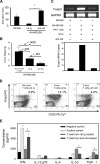Reversion of immune tolerance in advanced malignancy: modulation of myeloid-derived suppressor cell development by blockade of stem-cell factor function
- PMID: 17885078
- PMCID: PMC2200807
- DOI: 10.1182/blood-2007-04-086835
Reversion of immune tolerance in advanced malignancy: modulation of myeloid-derived suppressor cell development by blockade of stem-cell factor function
Abstract
Tumor growth induced a significant increase of myeloid-derived suppressor cells (MDSCs) in the tumor-bearing host. In our previous study, we showed that MDSCs induced tumor-specific T-cell tolerance and the development of T regulatory cells (Tregs). Tumor-derived factors have been implicated in the accumulation of MDSCs. We hypothesize that reduction of MDSC accumulation in tumor-bearing hosts, through the blockade of tumor factors, can prevent T-cell anergy and Treg development and thereby improve immune therapy for the treatment of advanced tumors. Several tumor-derived factors were identified by gene array analysis. Among the candidate factors, stem- cell factor (SCF) is expressed by various human and murine carcinomas and was selected for further study. Mice bearing tumor cells with SCF siRNA knockdown exhibited significantly reduced MDSC expansion and restored proliferative responses of tumor-infiltrating T cells. More importantly, blockade of SCF receptor (ckit)-SCF interaction by anti-ckit prevented tumor-specific T-cell anergy, Treg development, and tumor angiogenesis. Furthermore, the prevention of MDSC accumulation in conjunction with immune activation therapy showed synergistic therapeutic effect when treating mice bearing large tumors. This information supports the notion that modulation of MDSC development may be required to achieve effective immune-enhancing therapy for the treatment of advanced tumors.
Figures






Similar articles
-
Immune stimulatory receptor CD40 is required for T-cell suppression and T regulatory cell activation mediated by myeloid-derived suppressor cells in cancer.Cancer Res. 2010 Jan 1;70(1):99-108. doi: 10.1158/0008-5472.CAN-09-1882. Epub 2009 Dec 8. Cancer Res. 2010. PMID: 19996287 Free PMC article.
-
Myeloid-derived suppressor cells prevent type 1 diabetes in murine models.J Immunol. 2010 Nov 15;185(10):5828-34. doi: 10.4049/jimmunol.0903636. Epub 2010 Oct 18. J Immunol. 2010. PMID: 20956337 Free PMC article.
-
Targeting immune suppressing myeloid-derived suppressor cells in oncology.Crit Rev Oncol Hematol. 2011 Jan;77(1):12-9. doi: 10.1016/j.critrevonc.2010.02.004. Epub 2010 Mar 20. Crit Rev Oncol Hematol. 2011. PMID: 20304669 Free PMC article. Review.
-
The novel role of tyrosine kinase inhibitor in the reversal of immune suppression and modulation of tumor microenvironment for immune-based cancer therapies.Cancer Res. 2009 Mar 15;69(6):2514-22. doi: 10.1158/0008-5472.CAN-08-4709. Epub 2009 Mar 10. Cancer Res. 2009. PMID: 19276342 Free PMC article.
-
Myeloid derived suppressor cells and their role in tolerance induction in cancer.J Dermatol Sci. 2010 Jul;59(1):1-6. doi: 10.1016/j.jdermsci.2010.05.001. J Dermatol Sci. 2010. PMID: 20570112 Review.
Cited by
-
CD99-dependent expansion of myeloid-derived suppressor cells and attenuation of graft-versus-host disease.Mol Cells. 2012 Mar;33(3):259-67. doi: 10.1007/s10059-012-2227-z. Epub 2012 Feb 15. Mol Cells. 2012. PMID: 22350746 Free PMC article.
-
Role of myeloid-derived suppressor cells in autoimmune disease.World J Immunol. 2014 Mar 27;4(1):26-33. doi: 10.5411/wji.v4.i1.26. World J Immunol. 2014. PMID: 25621222 Free PMC article.
-
Targeting Multiple Receptors to Increase Checkpoint Blockade Efficacy.Int J Mol Sci. 2019 Jan 4;20(1):158. doi: 10.3390/ijms20010158. Int J Mol Sci. 2019. PMID: 30621125 Free PMC article. Review.
-
Myeloid-derived suppressor cells: the dark knight or the joker in viral infections?Immunol Rev. 2013 Sep;255(1):210-21. doi: 10.1111/imr.12084. Immunol Rev. 2013. PMID: 23947357 Free PMC article. Review.
-
Myeloid-derived suppressor cells: a novel therapeutic target.Curr Oncol Rep. 2009 Mar;11(2):87-93. doi: 10.1007/s11912-009-0014-6. Curr Oncol Rep. 2009. PMID: 19216839 Review.
References
-
- Pan PY, Zang Y, Weber K, Meseck ML, Chen SH. OX40 ligation enhances primary and memory cytotoxic T lymphocyte responses in an immunotherapy for hepatic colon metastases. Mol Ther. 2002;6:528–536. - PubMed
-
- Almand B, Clark JI, Nikitina E, et al. Increased production of immature myeloid cells in cancer patients: a mechanism of immunosuppression in cancer. J Immunol. 2001;166:678–689. - PubMed
-
- Schmielau J, Finn OJ. Activated granulocytes and granulocyte-derived hydrogen peroxide are the underlying mechanism of suppression of T-cell function in advanced cancer patients. Cancer Res. 2001;61:4756–4760. - PubMed
-
- Young MR, Lathers DM. Myeloid progenitor cells mediate immune suppression in patients with head and neck cancers. Int J Immunopharmacol. 1999;21:241–252. - PubMed
-
- Curiel TJ, Coukos G, Zou L, et al. Specific recruitment of regulatory T cells in ovarian carcinoma fosters immune privilege and predicts reduced survival. Nat Med. 2004;10:942–949. - PubMed
Publication types
MeSH terms
Substances
Grants and funding
LinkOut - more resources
Full Text Sources
Other Literature Sources

